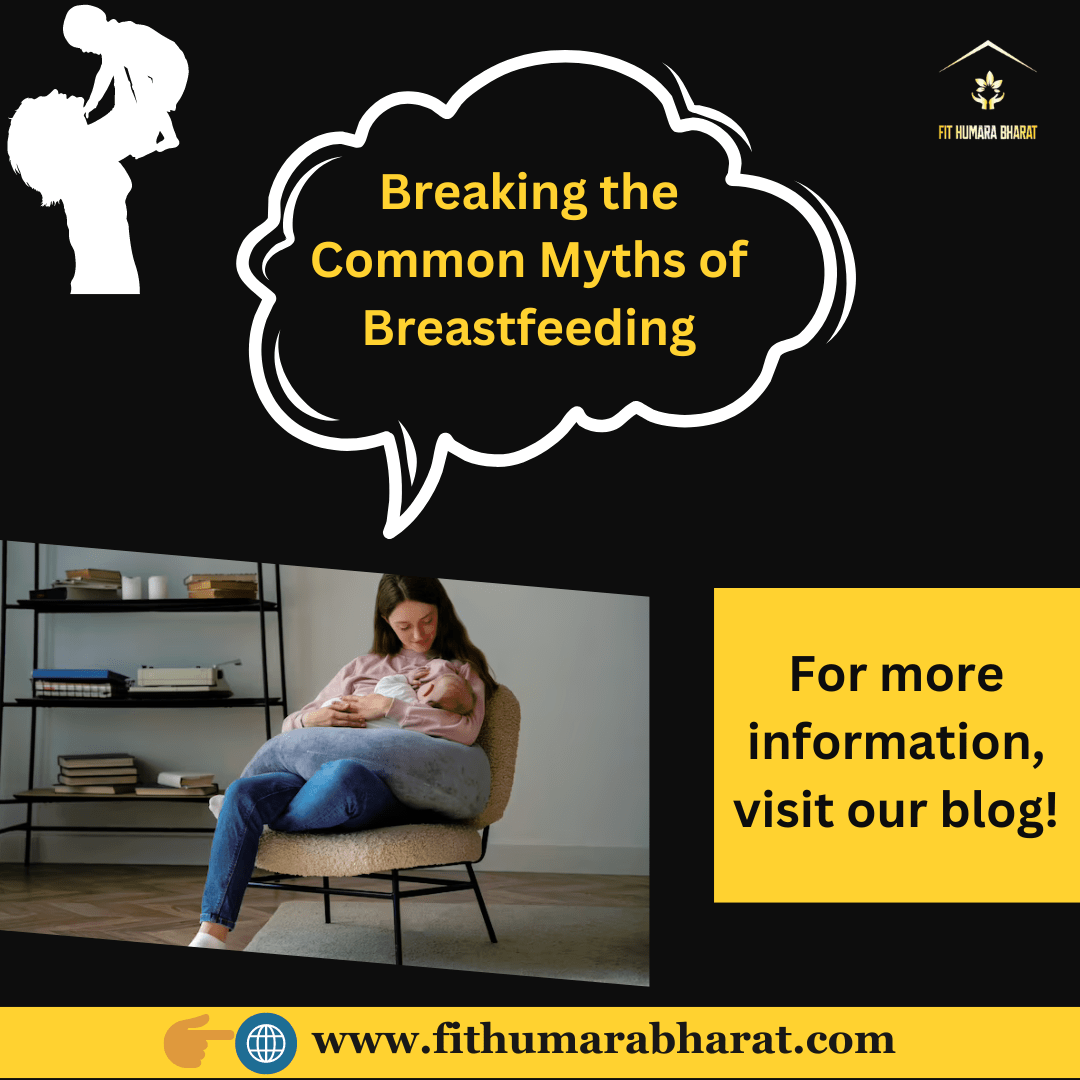Introduction
Mothers can feed their babies in a lovely and organic way by exclusively breastfeeding. However, it is not without its share of falsehoods and legends. In this detailed article, we focus on breaking the common myths of Breastfeeding, and give you with correct information depending on expert advice and scientific research. Here, we will split fact from fiction and allow mothers to make well-versed decisions about breastfeeding.
Myth 1: Breastfeeding is always natural and easy
The Reality
Against the famous belief, breastfeeding is not always an easy thing to do. Though it is a natural process, it can be hard for many new mothers, especially right after the delivery. Some babies may find it difficult to latch, and cause frustration and pain for the mother. Furthermore, breastfeeding needs patience and practice to establish enough milk supply and make sure the baby is getting enough nutrition.
Myth 2: Breastfeeding makes the breasts shapeless
The Reality
It is one of the most common distresses among mother. They think that breastfeeding will make their breasts loose or saggy. But, that is nothing but a myth. Breast sagging is mainly affected by factors like pregnancy itself, age, and gender, rather than just breastfeeding.
Actually, breastfeeding gives several perks to both the baby and the mother, and promote a powerful bond and give vital nutrients for the baby’s development and growth.
“A newborn has only three demands. They are warmth in the arms of its mother, food from her breasts, and security in the knowledge of her presence. Breastfeeding satisfies all three.”
-Dr. Grantly Dick-Read
Myth 3: Mothers should not breastfeed if they are sick
The Reality
It is a general fallacy that mothers should not breastfeed their babies whey they are sick. However, breastfeeding is expected when the mother is sick, because it aids safeguard the baby by passing on antibodies and increasing the baby’s immune system. In several instances, medicines advised by a doctor are safe to use during the breastfeeding. You should discuss with your doctor for further assistance on medicines during breastfeeding. so, you should be aware about one of this Myths of Breastfeeding.
Myth 4: Breastfeeding can cause overfeeding
The Reality
Babies who breastfeed have a natural knack to self-control their milk intake. Unlike bottle-feeding, where your baby can drink extra amount of milk, breastfeeding enables the baby to regulate the volume and flow of milk they get.
Breast milk composition varies eventually, according to the baby’s requirements, which aid in stopping overfeeding. It is important for mothers to trust their infant’s feed on demand and instincts.
“Nursing does not diminish the beauty of a woman’s breasts; it enhances their charm by making them look lived in and happy.”
-Robert A. Heinlein
Myth 5: Formula feeding is equal to breastfeeding
The Reality
While baby formula can be appropriate option when breastfeeding is not doable, but it is crucial to understand that breast milk gives exceptional perks that you can’t replace with formula.
Breast milk have essential nutrients, enzymes, and antibodies that guard against diseases and infections, and give optimal nutrition for the baby. Furthermore, breastfeeding promotes bonding and connection between the baby and the mother that add to the baby’s emotional health.
Myth 6: Breastfeeding stops conception
The Reality
Breastfeeding stops conception is another one of the Myths of Breastfeeding. Though breastfeeding can hold-up the return of fertility in most females, but it is not a guaranteed way of birth control. This misconception, also called as LAM or lactational amenorrhea method, depends on unique breastfeeding and particular conditions to stop pregnancy. But, individual conditions can differ, and its not a trusted form of contraception. You may consult your doctor for suitable contraceptive solutions while breastfeeding.
Myth 7: Breastfeeding is awkward in public
The Reality
Public nursing has generated discussion since some people find it improper or uncomfortable. But, breastfeeding in public places is guarded by law in several jurisdictions, identifying the significance of ensuring the health of both the baby and the mother.
Also, there are different accessories available in the market, like breastfeeding-friendly clothing and nursing covers, which give convenience and privacy, for breastfeeding mothers.
“Breastfeeding reminds us of the universal truth of abundance; the more we give out, the more we are filled up, and that divine nourishment – the source from which we all draw is, like a mother’s breast, ever full and ever flowing.”
-Sarah Buckley
Myth 8: Breastfeeding lead to discomfort and pain
The Reality
While new mother may experience some discomfort during the primary phase of breastfeeding, but continuous pain is abnormal and any signal or signs of that suggest an underlying concern.
Mothers can experience painful breastfeeding due to engorgement, thrush, incorrect latching or other factors.
You may remedy the issue and make sure that both the mother and the baby have a more comfortable nursing experience by seeking assistance from a doctor or lactation consultant.
“While breastfeeding may not seem the right choice for every parent, it is the best choice for every baby.”
-Amy Spangler
Myth 9: Several mothers struggle to produce enough milk
The Reality
Almost all women give their newborns the ideal amount of milk. The effectiveness of the latch, the frequency of breastfeeding, and the efficiency with which the baby is removing milk at each meal all affect the amount of breastmilk produced. Mothers need support because breastfeeding is not a ‘one woman’ job.
Support in the form of continued breastfeeding advice from medical professionals, assistance at home, and maintaining good health by eating and drinking healthily.
Myth 10: To produce milk, a mother must consume milk
The Reality
This is simply untrue. How efficiently breast milk is removed from the breast affects milk output. Remember that supply and demand are in effect in this situation. To suit your baby’s nutritional demands, your breast will start producing more or less milk. Although you don’t need cow’s milk to generate human milk, you do need water, so be sure to get enough of it while you’re nursing, suggested Madela.com.
“The benefits to the mother of immediate breastfeeding are innumerable, not the least of which after the weariness of labor and birth is the emotional gratification, the feeling of strength, the composure, and the sense of fulfillment that comes with the handling and suckling of the baby.”
-Ashley Montague
Myth 11: You’ll need to wean your child if you return to work
The Reality
After returning to work, many moms continue to breastfeed their babies. Check the regulations in your nation and at your place of employment first. If you have the right to a time and place to breastfeed while at work, you may be able to go home and do so, ask a family member or friend to bring your child to you, or express your milk and take it with you.
Try to find times during the day to express your milk if you are unable to breastfeed during working hours so that you may feed the baby right away when you come home. Even if you want to supplement part of your baby’s feeds with breastmilk, breastfeeding is still recommended while you are with your child. You should be aware about these kinds of Myths of Breastfeeding.

Breastfeeding Statistics
Let’s look at some facts to highlight the significance of dispelling breastfeeding myths and supporting breastfeeding:
- The World Health Organisation (WHO) advises exclusively breastfeeding newborns for the first six months of their lives in order to provide the best possible outcomes for their growth, development, and health.
- According to a study in The Lancet, over 800,000 lives may be saved annually if all infants were nursed within the first hour of life and only for the first six months.
- Breastfeeding rates in the US have risen over time, according to the Centres for Disease Control and Prevention (CDC). Compared to 73.7% in 2004, over 84.1% of babies began breastfeeding in 2018.
- Breastfeeding should be continued for at least 12 months, according to the American Academy of Paediatrics (AAP), with the introduction of supplementary foods after six months.
These figures demonstrate how important breastfeeding is to an infant’s health and wellbeing.
Conclusion
The journey of breastfeeding is fascinating and has many advantages for mothers and their newborns. In order to enable moms to make wise decisions about nursing, we try to dispel these widespread misconceptions and provide factual facts. Always keep in mind that every nursing experience is different, and getting help from medical professionals, lactation consultants, and support groups may be quite helpful all throughout this lovely and joyful process.
Thank You 
- Mothers’ and Grandmothers’ misconceptions and socio-cultural factors as barriers to exclusive breastfeeding: A qualitative study involving Health Workers in two rural districts of Ghana
- Perceptions and Practices regarding Breastfeeding among Postnatal Women at a District Tertiary Referral Government Hospital in Southern India
- Myths and facts about breastfeeding: does it prevent later atopic disease?
- Maternal food restrictions during breastfeeding
- Foods to Avoid While Breastfeeding? Experiences and Opinions of Polish Mothers and Healthcare Providers



 Sources
Sources